The Cambridge History of China. Vol. 12: Republican China, 1912-1949, Part 1
Подождите немного. Документ загружается.

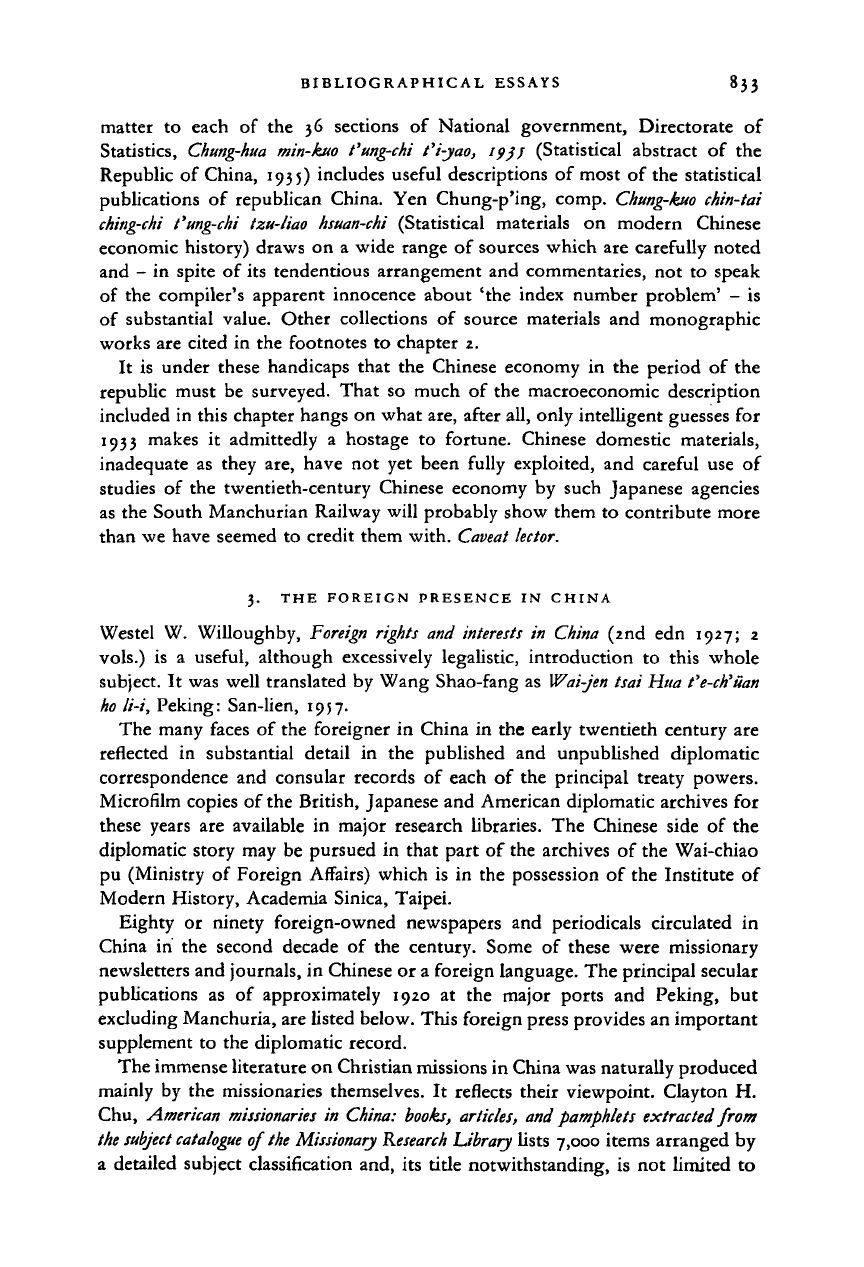
BIBLIOGRAPHICAL ESSAYS 833
matter
to
each
of the 36
sections
of
National government, Directorate
of
Statistics,
Chung-hua
min-kuo t'ung-chi t'i-yao,
193j
(Statistical abstract
of the
Republic
of
China, 1935) includes useful descriptions
of
most
of
the statistical
publications
of
republican China.
Yen
Chung-p'ing, comp.
Chung-kuo
chin-tai
ching-chi
t'ung-chi tzu-liao
hsuan-chi
(Statistical materials
on
modern Chinese
economic history) draws
on a
wide range
of
sources which are carefully noted
and
- in
spite
of
its tendentious arrangement
and
commentaries,
not to
speak
of the compiler's apparent innocence about
'the
index number problem'
- is
of substantial value. Other collections
of
source materials
and
monographic
works are cited
in the
footnotes
to
chapter
1.
It
is
under these handicaps that
the
Chinese economy
in the
period
of the
republic must
be
surveyed. That
so
much
of
the macroeconomic description
included
in
this chapter hangs
on
what are, after all, only intelligent guesses
for
1933 makes
it
admittedly
a
hostage
to
fortune. Chinese domestic materials,
inadequate
as
they are, have
not yet
been fully exploited,
and
careful
use of
studies
of
the twentieth-century Chinese economy
by
such Japanese agencies
as the South Manchurian Railway will probably show them
to
contribute more
than we have seemed
to
credit them with.
Caveat
lector.
3.
THE
FOREIGN PRESENCE
IN
CHINA
Westel
W.
Willoughby,
Foreign
rights and
interests
in
China
(2nd edn
1927;
2
vols.)
is a
useful, although excessively legalistic, introduction
to
this whole
subject.
It
was well translated
by
Wang Shao-fang
as
Wai-jen
tsai Hua
t'e-ch'uan
ho
li-i, Peking: San-lien, 1957.
The many faces
of
the foreigner
in
China
in the
early twentieth century
are
reflected
in
substantial detail
in the
published
and
unpublished diplomatic
correspondence
and
consular records
of
each
of the
principal treaty powers.
Microfilm copies
of
the British, Japanese and American diplomatic archives
for
these years
are
available
in
major research libraries.
The
Chinese side
of the
diplomatic story may
be
pursued
in
that part
of
the archives
of
the Wai-chiao
pu (Ministry
of
Foreign Affairs) which
is in the
possession
of
the Institute
of
Modern History, Academia Sinica, Taipei.
Eighty
or
ninety foreign-owned newspapers
and
periodicals circulated
in
China
in the
second decade
of the
century. Some
of
these were missionary
newsletters and journals,
in
Chinese
or
a foreign language. The principal secular
publications
as of
approximately
1920 at the
major ports
and
Peking,
but
excluding Manchuria, are listed below. This foreign press provides an important
supplement
to
the diplomatic record.
The immense literature on Christian missions in China was naturally produced
mainly
by the
missionaries themselves.
It
reflects their viewpoint. Clayton
H.
Chu, American missionaries
in
China: books, articles, and pamphlets extracted from
the
subject catalogue
of
the Missionary Research Library lists 7,000 items arranged
by
a detailed subject classification and,
its
title notwithstanding,
is not
limited
to
Cambridge Histories Online © Cambridge University Press, 2008
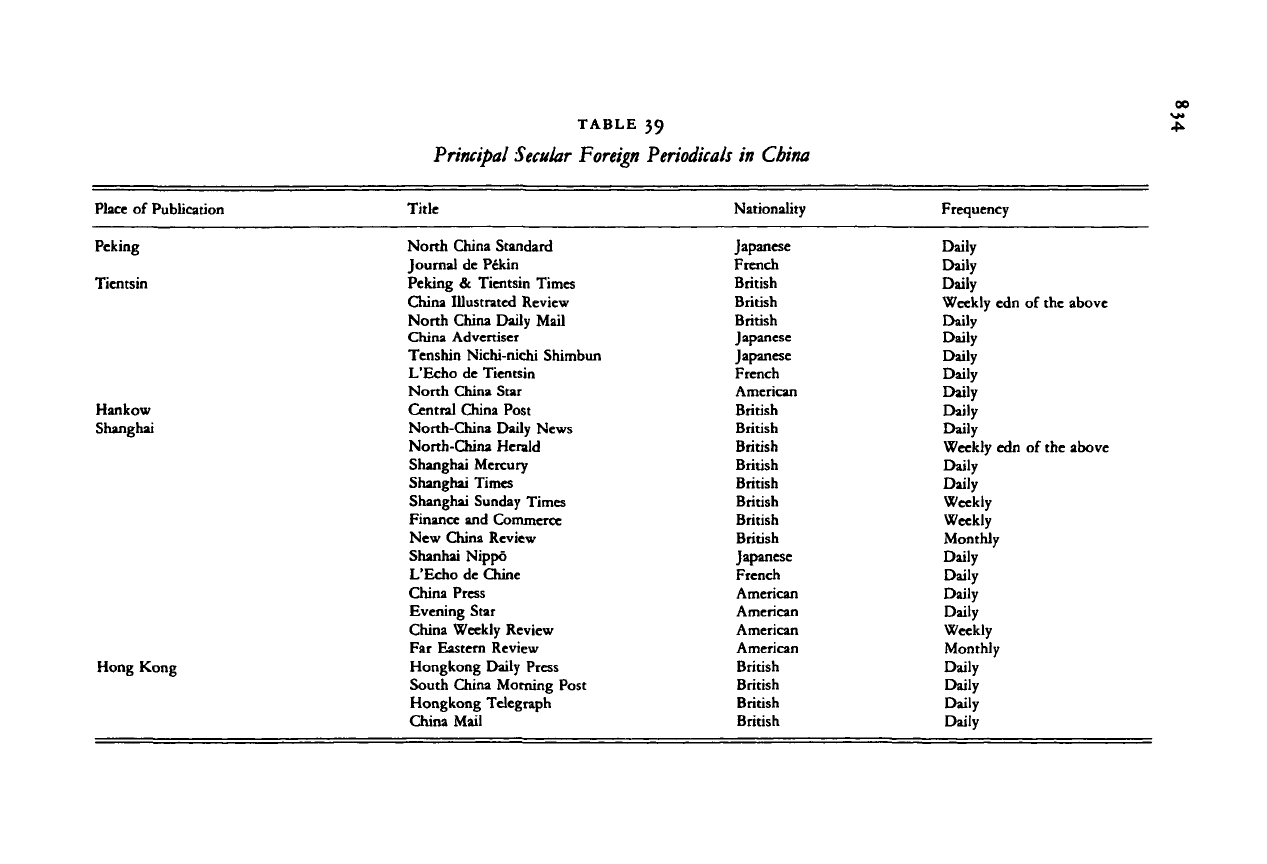
TABLE 39
Principal
Secular Foreign Periodicals
in China
00
-p.
Place of Publication
Title Nationality Frequency
Peking
Tientsin
Hankow
Shanghai
Hong Kong
North China Standard
Journal de Pekin
Peking & Tientsin Times
China Illustrated Review
North China Daily Mail
China Advertiser
Tenshin Nichi-nichi Shimbun
L'Echo
de Tientsin
North China Star
Central China Post
North-China Daily News
North-China Herald
Shanghai Mercury
Shanghai Times
Shanghai Sunday Times
Finance and Commerce
New China Review
Shanhai Nippd
L'Echo
de Chine
China Press
Evening Star
China Weekly Review
Far Eastern Review
Hongkong Daily Press
South China Morning Post
Hongkong Telegraph
China Mail
Japanese
French
British
British
British
Japanese
Japanese
French
American
British
British
British
British
British
British
British
British
Japanese
French
American
American
American
American
British
British
British
British
Daily
Daily
Daily
Weekly edn of the above
Daily
Daily
Daily
Daily
Daily
Daily
Daily
Weekly edn of the above
Daily
Daily
Weekly
Weekly
Monthly
Daily
Daily
Daily
Daily
Weekly
Monthly
Daily
Daily
Daily
Daily
Cambridge Histories Online © Cambridge University Press, 2008
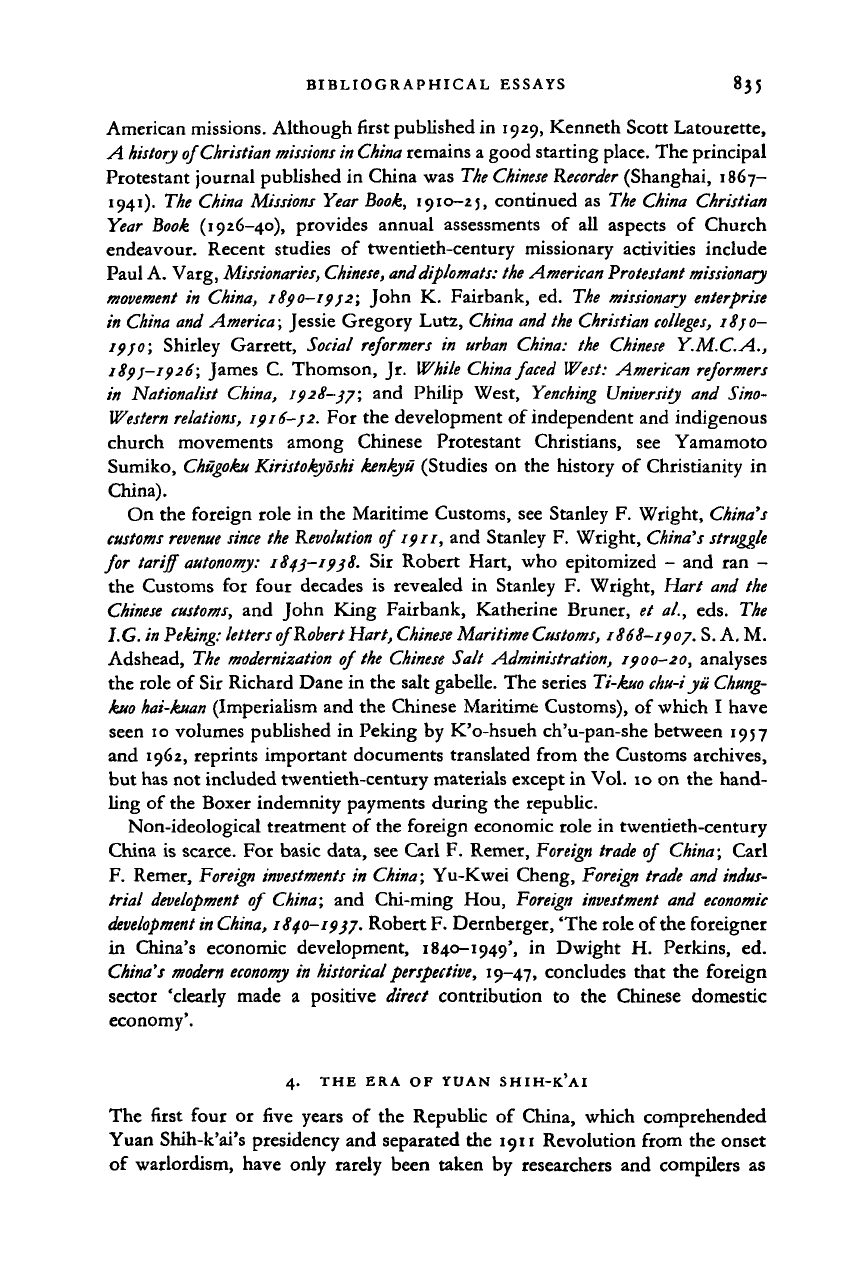
BIBLIOGRAPHICAL ESSAYS 835
American missions. Although first published in 1929, Kenneth Scott Latourette,
A
history
of
Christian missions in China
remains a good starting place. The principal
Protestant journal published in China was
The Chinese Recorder
(Shanghai, 1867-
1941).
The
China Missions
Year
Book,
1910-25, continued as The
China
Christian
Year Book (1926-40), provides annual assessments of all aspects of Church
endeavour. Recent studies of twentieth-century missionary activities include
Paul A. Varg,
Missionaries,
Chinese,
and
diplomats:
the American Protestant missionary
movement
in China, 1890-19 j
2;
John K. Fairbank, ed. The
missionary enterprise
in
China and
America; Jessie Gregory Lutz,
China and the Christian
colleges,
18
jo-
19jo;
Shirley Garrett, Social
reformers
in urban China: the
Chinese
Y.M.C.A.,
189J-1926; James C. Thomson, Jr. While
China faced
West: American
reformers
in Nationalist China,
1928-}-/;
and Philip West,
Yenching University
and Sino-
Western
relations,
1916-/2. For the development of independent and indigenous
church movements among Chinese Protestant Christians, see Yamamoto
Sumiko,
Chugoku Kiristokyoshi
kenkyu (Studies on the history of Christianity in
China).
On the foreign role in the Maritime Customs, see Stanley F. Wright, China's
customs revenue since the Revolution
of if n, and Stanley F. Wright,
China's struggle
for tariff
autonomy:
1843-1938. Sir Robert Hart, who epitomized - and ran -
the Customs for four decades is revealed in Stanley F. Wright, Hart and the
Chinese
customs,
and John King Fairbank, Katherine Bruner, et a/., eds. The
I.G.
in
Peking:
letters
of Robert Hart,
Chinese Maritime
Customs,
1868-1907.
S.
A. M.
Adshead, The
modernization
of
the Chinese
Salt Administration, 1900-20, analyses
the role of Sir Richard Dane in the salt gabelle. The series Ti-kuo chu-iyii
Chung-
kuo
hai-kuan
(Imperialism and the Chinese Maritime Customs), of which I have
seen 10 volumes published in Peking by K'o-hsueh ch'u-pan-she between 1957
and 1962, reprints important documents translated from the Customs archives,
but has not included twentieth-century materials except in Vol. 10 on the hand-
ling of the Boxer indemnity payments during the republic.
Non-ideological treatment of the foreign economic role in twentieth-century
China is scarce. For basic data, see Carl F. Remer,
Foreign trade
of China; Carl
F.
Remer,
Foreign investments
in
China;
Yu-Kwei Cheng,
Foreign trade
and
indus-
trial
development
of
China;
and Chi-ming Hou,
Foreign investment
and
economic
development in
China,
1840-1937. Robert F. Dernberger, 'The role of the foreigner
in China's economic development, 1840-1949', in Dwight H. Perkins, ed.
China's modern economy
in
historical
perspective,
19-47, concludes that the foreign
sector 'clearly made a positive direct contribution to the Chinese domestic
economy'.
4.
THE ERA OF YUAN SHIH-K'AI
The first four or five years of the Republic of China, which comprehended
Yuan Shih-k'ai's presidency and separated the 1911 Revolution from the onset
of warlordism, have only rarely been taken by researchers and compilers as
Cambridge Histories Online © Cambridge University Press, 2008
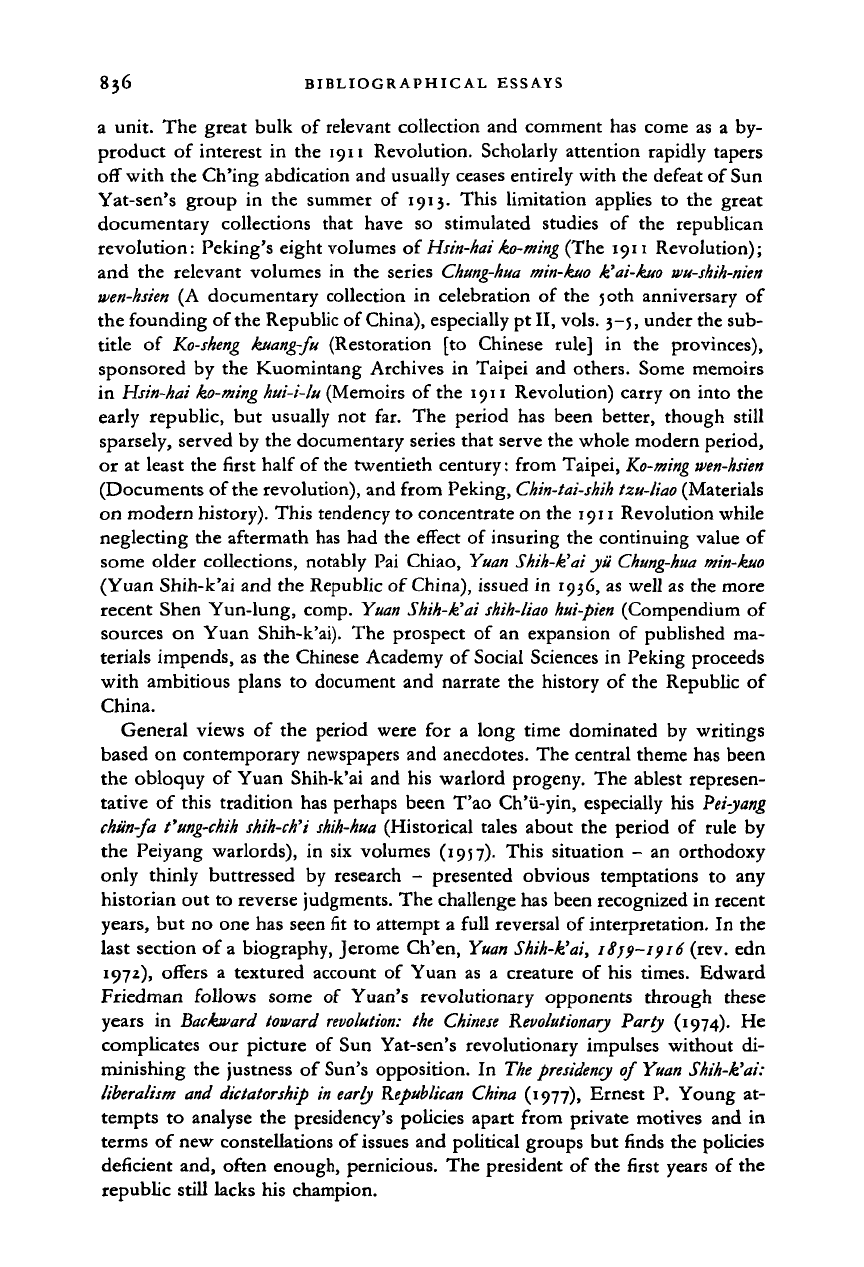
836 BIBLIOGRAPHICAL ESSAYS
a unit. The great bulk of relevant collection and comment has come as a by-
product of interest in the 1911 Revolution. Scholarly attention rapidly tapers
off with the Ch'ing abdication and usually ceases entirely with the defeat of Sun
Yat-sen's group in the summer of 1913. This limitation applies to the great
documentary collections that have so stimulated studies of the republican
revolution: Peking's eight volumes of
Hsin-hai'
ko-ming
(The 1911 Revolution);
and the relevant volumes in the series
Chung-hua
min-kuo k'ai-kuo
wu-shih-nien
wen-hsien
(A documentary collection in celebration of the
5
oth anniversary of
the founding of the Republic of
China),
especially pt II, vols. 3-5, under the sub-
title of
Ko-sheng
kuang-fu (Restoration [to Chinese rule] in the provinces),
sponsored by the Kuomintang Archives in Taipei and others. Some memoirs
in Hsin-hai
ko-ming
hui-i-lu (Memoirs of the 1911 Revolution) carry on into the
early republic, but usually not far. The period has been better, though still
sparsely, served by the documentary series that serve the whole modern period,
or at least the first half of the twentieth century: from Taipei,
Ko-ming wen-hsien
(Documents of the revolution), and from Peking,
Chin-tai-shih tzu-liao
(Materials
on modern history). This tendency to concentrate on the 1911 Revolution while
neglecting the aftermath has had the effect of insuring the continuing value of
some older collections, notably Pai Chiao, Yuan Shih-k'ai yu
Chung-hua
min-kuo
(Yuan Shih-k'ai and the Republic of China), issued in 1936, as well as the more
recent Shen Yun-lung, comp. Yuan Shih-k'ai
shih-liao hui-pien
(Compendium of
sources on Yuan Shih-k'ai). The prospect of an expansion of published ma-
terials impends, as the Chinese Academy of Social Sciences in Peking proceeds
with ambitious plans to document and narrate the history of the Republic of
China.
General views of the period were for a long time dominated by writings
based on contemporary newspapers and anecdotes. The central theme has been
the obloquy of Yuan Shih-k'ai and his warlord progeny. The ablest represen-
tative of this tradition has perhaps been T'ao Ch'ii-yin, especially his
Pei-yang
chun-fa
t'ung-chih
shih-ch'i shih-hua
(Historical tales about the period of rule by
the Peiyang warlords), in six volumes (1957). This situation - an orthodoxy
only thinly buttressed by research - presented obvious temptations to any
historian out to reverse judgments. The challenge has been recognized in recent
years,
but no one has seen fit to attempt a full reversal of interpretation. In the
last section of a biography, Jerome Ch'en, Yuan Shih-k'ai, 18j9-1916 (rev. edn
1972),
offers a textured account of Yuan as a creature of his times. Edward
Friedman follows some of Yuan's revolutionary opponents through these
years in Backward toward revolution: the Chinese Revolutionary Party (1974). He
complicates our picture of Sun Yat-sen's revolutionary impulses without di-
minishing the justness of Sun's opposition. In
The presidency
of Yuan Shih-k'ai:
liberalism and dictatorship in early Republican China (1977), Ernest P. Young at-
tempts to analyse the presidency's policies apart from private motives and in
terms of new constellations of issues and political groups but finds the policies
deficient and, often enough, pernicious. The president of the first years of the
republic still lacks his champion.
Cambridge Histories Online © Cambridge University Press, 2008
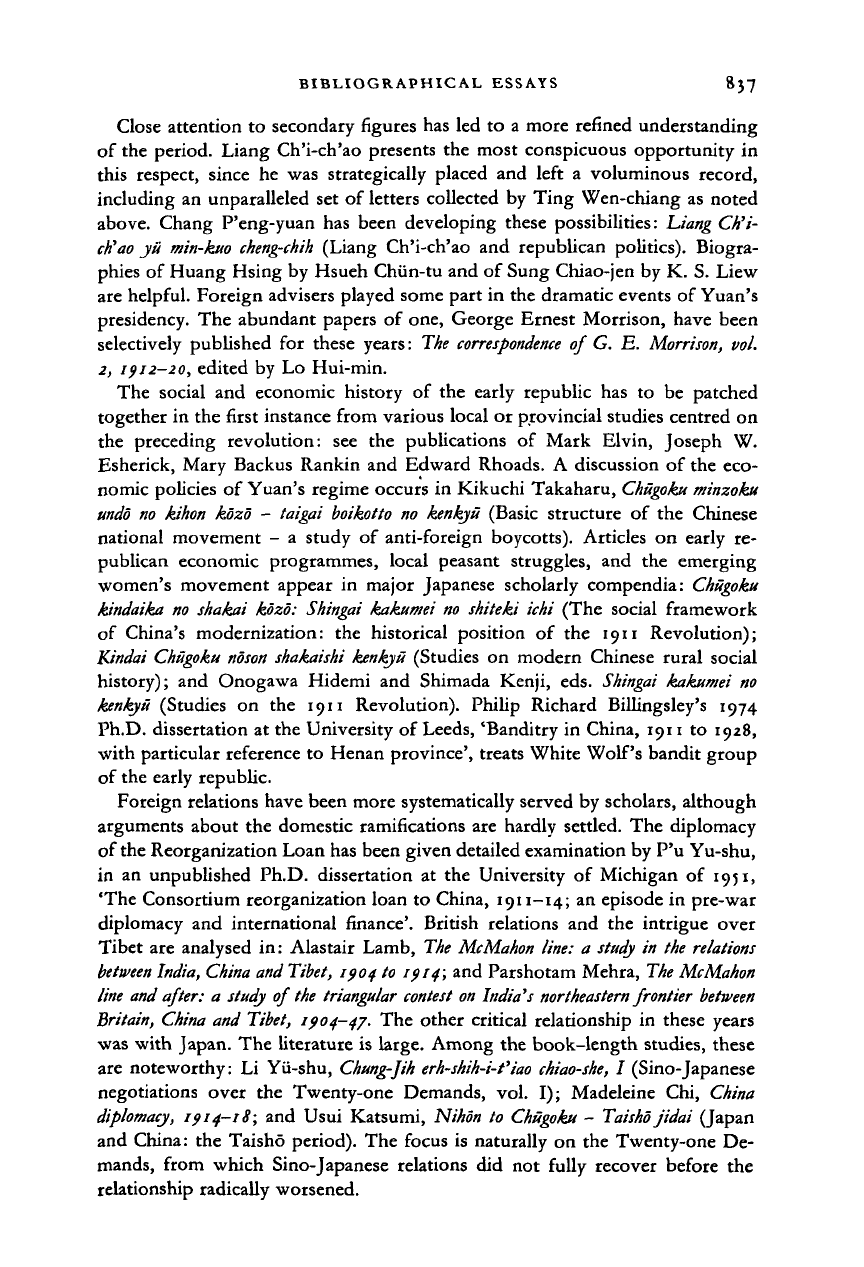
BIBLIOGRAPHICAL ESSAYS 837
Close attention to secondary figures has led to a more refined understanding
of the period. Liang Ch'i-ch'ao presents the most conspicuous opportunity in
this respect, since he was strategically placed and left a voluminous record,
including an unparalleled set of letters collected by Ting Wen-chiang as noted
above. Chang P'eng-yuan has been developing these possibilities: Liang Ch'i-
ch'ao
yii min-kuo
cheng-chih
(Liang Ch'i-ch'ao and republican politics). Biogra-
phies of Huang Hsing by Hsueh Chiin-tu and of Sung Chiao-jen by K. S. Liew
are helpful. Foreign advisers played some part in the dramatic events of Yuan's
presidency. The abundant papers of one, George Ernest Morrison, have been
selectively published for these years: The
correspondence
of G. E.
Morrison,
vol.
2,
1912-20, edited by Lo Hui-min.
The social and economic history of the early republic has to be patched
together in the first instance from various local or provincial studies centred on
the preceding revolution: see the publications of Mark Elvin, Joseph W.
Esherick, Mary Backus Rankin and Edward Rhoads. A discussion of the eco-
nomic policies of Yuan's regime occurs in Kikuchi Takaharu,
Chugoku
minzoku
undo
no kihon kozo - taigai boikotto no kenkyu (Basic structure of the Chinese
national movement - a study of anti-foreign boycotts). Articles on early re-
publican economic programmes, local peasant struggles, and the emerging
women's movement appear in major Japanese scholarly compendia: Chugoku
kindaika no shakai kozo: Shingai kakumei no shiteki ichi (The social framework
of China's modernization: the historical position of the 1911 Revolution);
Kirtdai Chugoku noson shakaishi
kenkyu (Studies on modern Chinese rural social
history); and Onogawa Hidemi and Shimada Kenji, eds. Shingai kakumei no
kenkyu (Studies on the 1911 Revolution). Philip Richard Billingsley's 1974
Ph.D.
dissertation at the University of Leeds, 'Banditry in China, 1911 to 1928,
with particular reference to Henan province', treats White Wolf's bandit group
of the early republic.
Foreign relations have been more systematically served by scholars, although
arguments about the domestic ramifications are hardly settled. The diplomacy
of the Reorganization Loan has been given detailed examination by P'u Yu-shu,
in an unpublished Ph.D. dissertation at the University of Michigan of 1951,
'The Consortium reorganization loan to China, 1911-14; an episode in pre-war
diplomacy and international finance'. British relations and the intrigue over
Tibet are analysed in: Alastair Lamb, The
McMahon
line:
a
study
in the
relations
between
India,
China and
Tibet,
1904
to 1914; and Parshotam Mehra,
The McMahon
line and
after:
a study of
the triangular contest
on India's
northeastern frontier between
Britain,
China
and Tibet, 1904-47. The other critical relationship in these years
was with Japan. The literature is large. Among the book-length studies, these
are noteworthy: Li Yu-shu,
Chung-Jih erh-shih-i-t'iao
chiao-she,
I (Sino-Japanese
negotiations over the Twenty-one Demands, vol. I); Madeleine Chi, China
diplomacy,
1914-18; and Usui Katsumi, Nihon to
Chugoku
- Taisho jidai (Japan
and China: the Taisho period). The focus is naturally on the Twenty-one De-
mands, from which Sino-Japanese relations did not fully recover before the
relationship radically worsened.
Cambridge Histories Online © Cambridge University Press, 2008
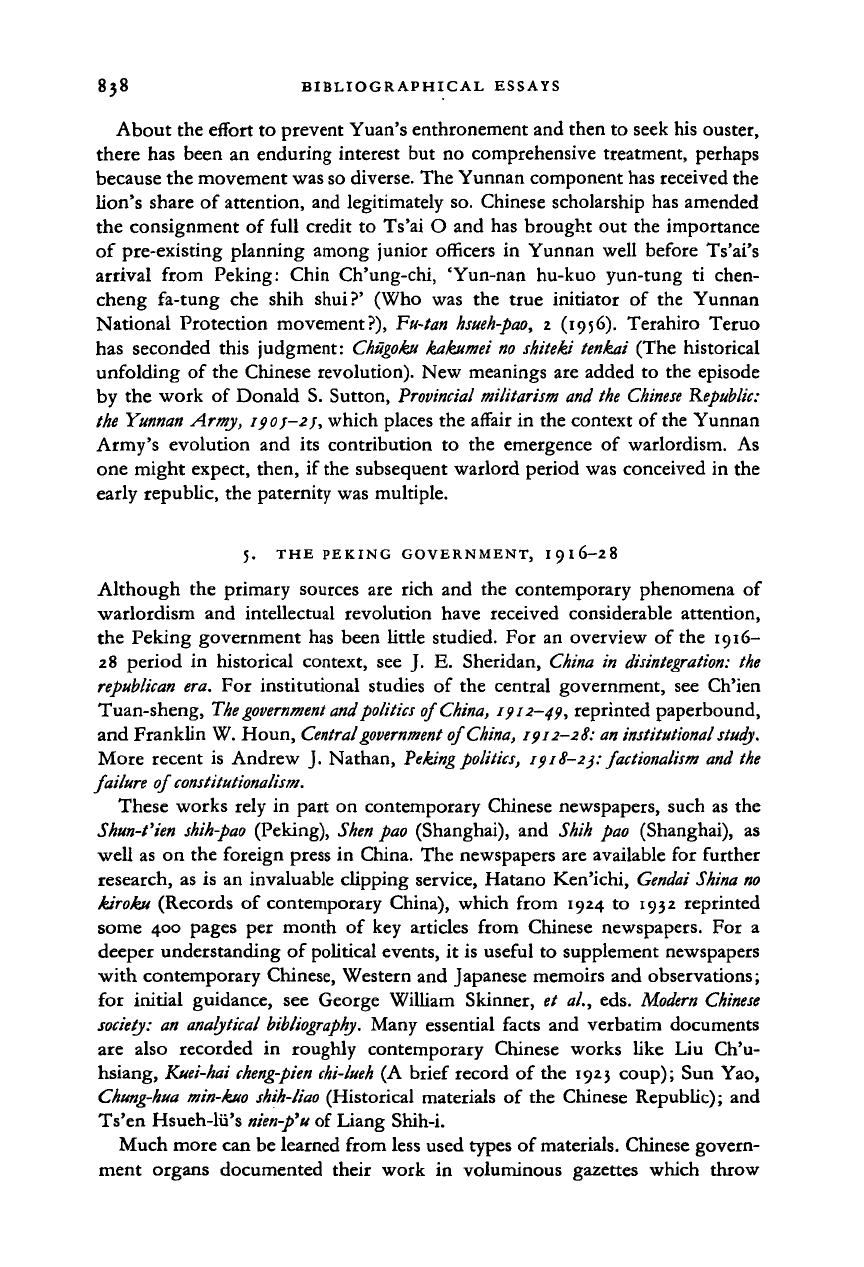
838 BIBLIOGRAPHICAL ESSAYS
About the effort to prevent Yuan's enthronement and then to seek his ouster,
there has been an enduring interest but no comprehensive treatment, perhaps
because the movement was so diverse. The Yunnan component has received the
lion's share of attention, and legitimately so. Chinese scholarship has amended
the consignment of full credit to Ts'ai O and has brought out the importance
of pre-existing planning among junior officers in Yunnan well before Ts'ai's
arrival from Peking: Chin Ch'ung-chi, 'Yun-nan hu-kuo yun-tung ti chen-
cheng fa-tung che shih shui?' (Who was the true initiator of the Yunnan
National Protection movement?), Fu-tan
hsueh-pao,
2 (1956). Terahiro Teruo
has seconded this judgment:
Chugoku
kakumei no shiteki tenkai (The historical
unfolding of the Chinese revolution). New meanings are added to the episode
by the work of Donald S. Sutton,
Provincial
militarism and
the Chinese
Republic:
the Yunnan Army, ipof-2j, which places the affair in the context of the Yunnan
Army's evolution and its contribution to the emergence of warlordism. As
one might expect, then, if the subsequent warlord period was conceived in the
early republic, the paternity was multiple.
5. THE PEKING GOVERNMENT,
I
9 I 6-2
8
Although the primary sources are rich and the contemporary phenomena of
warlordism and intellectual revolution have received considerable attention,
the Peking government has been little studied. For an overview of the 1916-
28 period in historical context, see J. E. Sheridan, China in
disintegration:
the
republican
era. For institutional studies of the central government, see Ch'ien
Tuan-sheng,
The government
and
politics
of China, 1912-49, reprinted paperbound,
and Franklin W. Houn, Central
government
of
China,
1912-28:
an institutional
study.
More recent is Andrew J. Nathan,
Peking
politics,
1918-2y.
factionalism
and the
failure of constitutionalism.
These works rely in part on contemporary Chinese newspapers, such as the
Shun-t'ien
shih-pao
(Peking),
Shen
pao (Shanghai), and Shih pao (Shanghai), as
well as on the foreign press in China. The newspapers are available for further
research, as is an invaluable clipping service, Hatano Ken'ichi,
Gendai Shina no
kiroku (Records of contemporary China), which from 1924 to 1932 reprinted
some 400 pages per month of key articles from Chinese newspapers. For a
deeper understanding of political events, it is useful to supplement newspapers
with contemporary Chinese, Western and Japanese memoirs and observations;
for initial guidance, see George William Skinner, et al., eds.
Modern Chinese
society:
an
analytical
bibliography.
Many essential facts and verbatim documents
are also recorded in roughly contemporary Chinese works like Liu Ch'u-
hsiang,
Kuei-hai cheng-pien chi-lueh
(A brief record of the 1923 coup); Sun Yao,
Chung-hua
min-kuo
shih-liao
(Historical materials of the Chinese Republic); and
Ts'en Hsueh-lii's
nien-p'u
of Liang Shih-i.
Much more can be learned from less used types of materials. Chinese govern-
ment organs documented their work in voluminous gazettes which throw
Cambridge Histories Online © Cambridge University Press, 2008
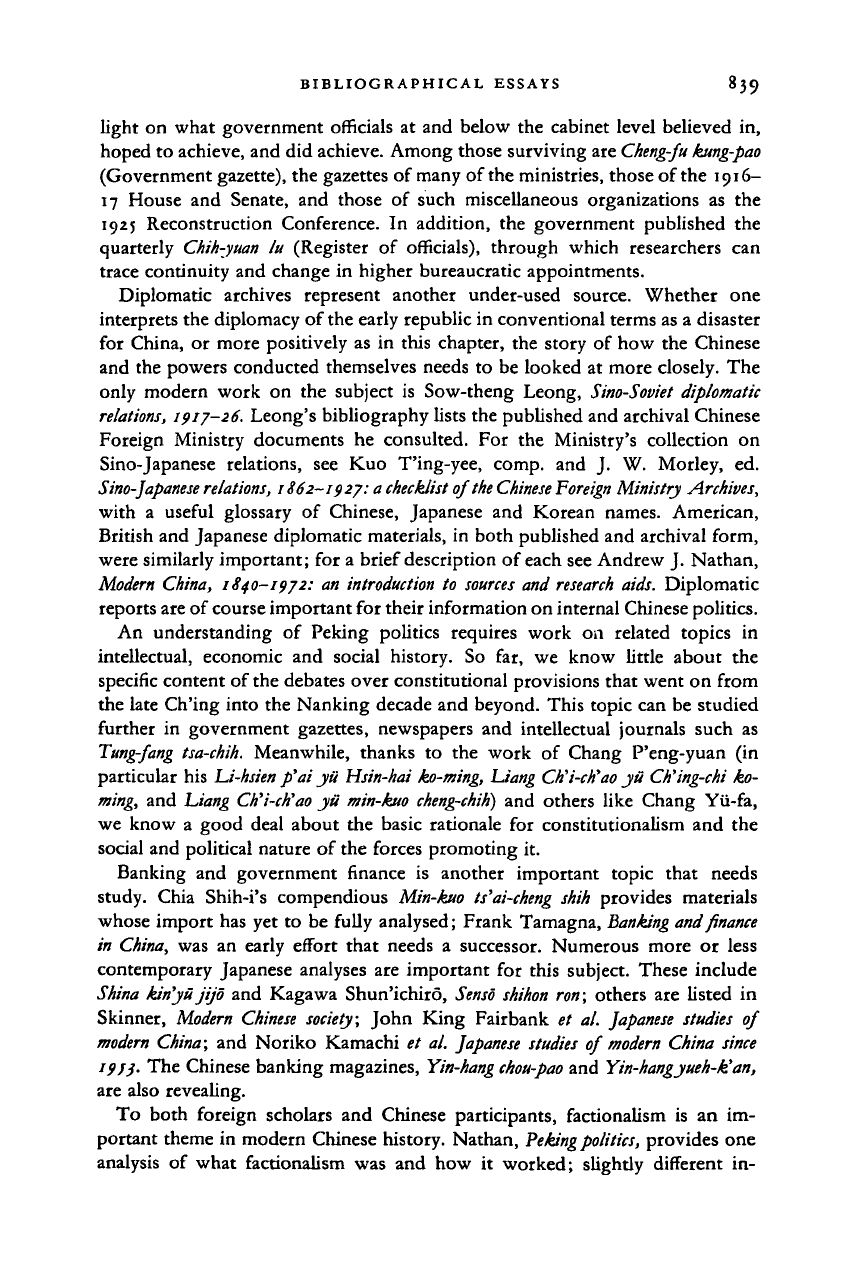
BIBLIOGRAPHICAL ESSAYS 839
light on what government officials at and below the cabinet level believed in,
hoped to achieve, and did achieve. Among those surviving are
Cheng-fu kung-pao
(Government gazette), the gazettes of many of the ministries, those of the 1916-
17 House and Senate, and those of such miscellaneous organizations as the
1925 Reconstruction Conference. In addition, the government published the
quarterly
Chih-yuan
lu (Register of officials), through which researchers can
trace continuity and change in higher bureaucratic appointments.
Diplomatic archives represent another under-used source. Whether one
interprets the diplomacy of the early republic in conventional terms as a disaster
for China, or more positively as in this chapter, the story of how the Chinese
and the powers conducted themselves needs to be looked at more closely. The
only modern work on the subject is Sow-theng Leong,
Sino-Soviet diplomatic
relations,
1917-26. Leong's bibliography lists the published and archival Chinese
Foreign Ministry documents he consulted. For the Ministry's collection on
Sino-Japanese relations, see Kuo T'ing-yee, comp. and J. W. Morley, ed.
Sino-Japanese
relations, 1862-1927: a checklist of the
Chinese Foreign
Ministry Archives,
with a useful glossary of Chinese, Japanese and Korean names. American,
British and Japanese diplomatic materials, in both published and archival form,
were similarly important; for a brief description of each see Andrew J. Nathan,
Modern China, 1840-19/2: an introduction to sources and
research
aids. Diplomatic
reports are of course important for their information on internal Chinese politics.
An understanding of Peking politics requires work on related topics in
intellectual, economic and social history. So far, we know little about the
specific content of the debates over constitutional provisions that went on from
the late Ch'ing into the Nanking decade and beyond. This topic can be studied
further in government gazettes, newspapers and intellectual journals such as
Tung-fang
tsa-chih.
Meanwhile, thanks to the work of Chang P'eng-yuan (in
particular his Li-hsien p'ai yii Hsin-hai ko-ming, Liang Ch'i-ch'ao yii Ch'ing-chi ho-
ming, and Liang Ch'i-ch'ao yu min-kuo
cheng-chih)
and others like Chang Yii-fa,
we know a good deal about the basic rationale for constitutionalism and the
social and political nature of the forces promoting it.
Banking and government finance is another important topic that needs
study. Chia Shih-i's compendious Min-kuo
ts'ai-cheng
shih provides materials
whose import has yet to be fully analysed; Frank Tamagna,
Banking
and finance
in China, was an early effort that needs a successor. Numerous more or less
contemporary Japanese analyses are important for this subject. These include
Shina kin'yu jijo and Kagawa Shun'ichiro,
Senso shihon
ron; others are listed in
Skinner, Modern Chinese society; John King Fairbank et al. Japanese studies of
modern China; and Noriko Kamachi et al. Japanese studies of modern China since
19}}.
The Chinese banking magazines, Yin-hang
chou-pao
and Yin-hangyueh-k'an,
are also revealing.
To both foreign scholars and Chinese participants, factionalism is an im-
portant theme in modern Chinese history. Nathan,
Peking
politics,
provides one
analysis of what factionalism was and how it worked; slightly different in-
Cambridge Histories Online © Cambridge University Press, 2008
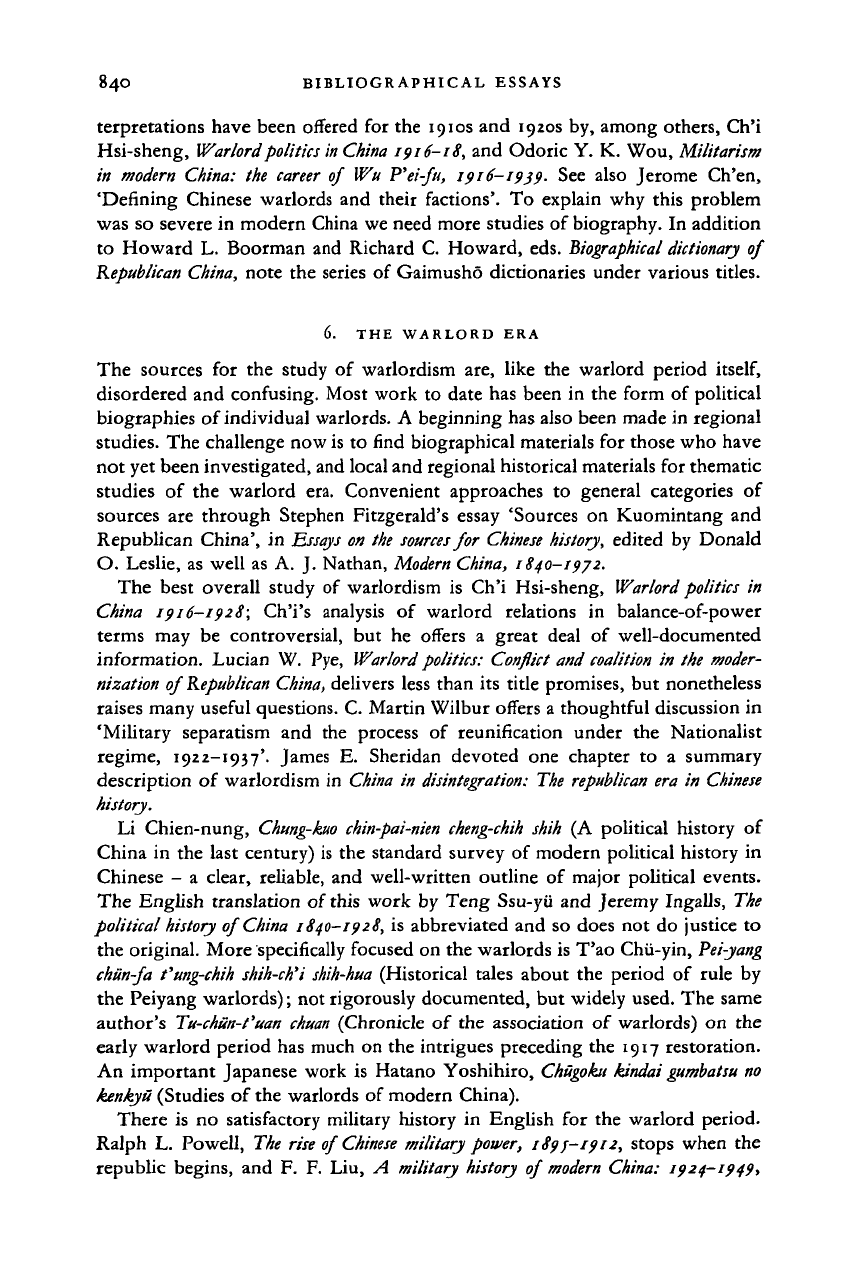
840 BIBLIOGRAPHICAL ESSAYS
terpretations have been offered for the 1910s and 1920s by, among others, Ch'i
Hsi-sheng, Warlord
politics in China
1916-18, and Odoric Y. K. Wou, Militarism
in
modern
China: the
career
of Wu P'ei-fu, 1916-1939. See also Jerome Ch'en,
'Defining Chinese warlords and their factions'. To explain why this problem
was so severe in modern China we need more studies of biography. In addition
to Howard L. Boorman and Richard C. Howard, eds.
Biographical dictionary
of
Republican
China,
note the series of Gaimusho dictionaries under various titles.
6. THE WARLORD ERA
The sources for the study of warlordism are, like the warlord period
itself,
disordered and confusing. Most work to date has been in the form of political
biographies of individual warlords. A beginning has also been made in regional
studies. The challenge now is to find biographical materials for those who have
not yet been investigated, and local and regional historical materials for thematic
studies of the warlord era. Convenient approaches to general categories of
sources are through Stephen Fitzgerald's essay 'Sources on Kuomintang and
Republican China', in
Essays
on the sources for
Chinese
history,
edited by Donald
O. Leslie, as well as A. J. Nathan,
Modern
China,
1840-1972.
The best overall study of warlordism is Ch'i Hsi-sheng,
Warlord politics
in
China 1916-1928; Ch'i's analysis of warlord relations in balance-of-power
terms may be controversial, but he offers a great deal of well-documented
information. Lucian W. Pye,
Warlord
politics:
Conflict
and
coalition
in the
moder-
nization of
Republican
China,
delivers less than its title promises, but nonetheless
raises many useful questions. C. Martin Wilbur offers a thoughtful discussion in
'Military separatism and the process of reunification under the Nationalist
regime, 1922-1937'. James E. Sheridan devoted one chapter to a summary
description of warlordism in
China
in
disintegration:
The
republican
era in
Chinese
history.
Li Chien-nung,
Chung-kuo chin-pai-nien cheng-chih
shih (A political history of
China in the last century) is the standard survey of modern political history in
Chinese - a clear, reliable, and well-written outline of major political events.
The English translation of this work by Teng Ssu-yii and Jeremy Ingalls, The
political
history
of
China
1840-1928, is abbreviated and so does not do justice to
the original. More specifically focused on the warlords is T'ao Chii-yin,
Pei-yang
chun-fa
t'ung-chih
shih-ch'i shih-hua
(Historical tales about the period of rule by
the Peiyang warlords); not rigorously documented, but widely used. The same
author's
Tu-chun-t'uan chuan
(Chronicle of the association of warlords) on the
early warlord period has much on the intrigues preceding the 1917 restoration.
An important Japanese work is Hatano Yoshihiro,
Chiigoku kindai gumbatsu
no
kenkyu (Studies of the warlords of modern China).
There is no satisfactory military history in English for the warlord period.
Ralph L. Powell, The rise of
Chinese military
power,
189J-1912, stops when the
republic begins, and F. F. Liu, A military history of
modern
China: 1924-1949,
Cambridge Histories Online © Cambridge University Press, 2008
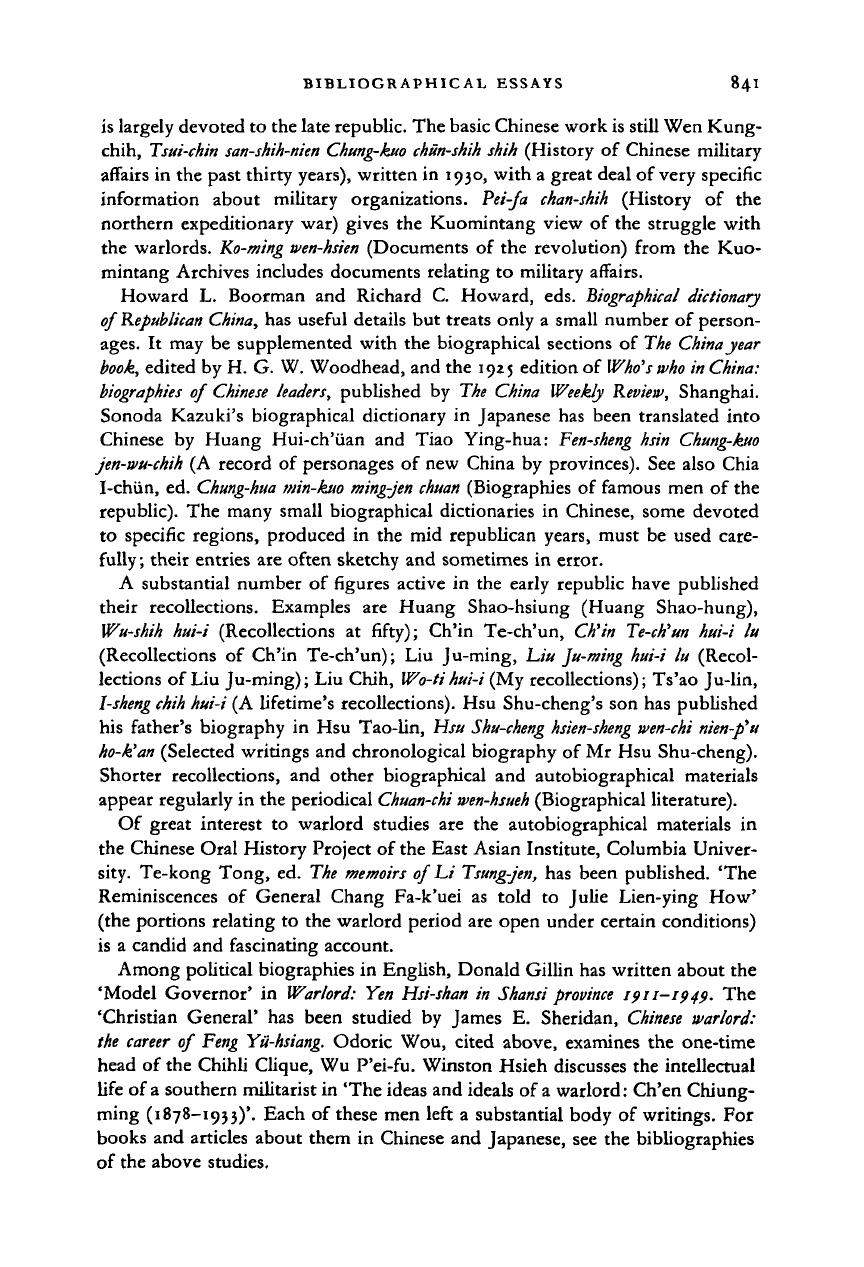
BIBLIOGRAPHICAL ESSAYS 841
is largely devoted to the late republic. The basic Chinese work is still Wen Kung-
chih, Tsui-chin san-shih-nien Chung-kuo chiin-shih shih (History of Chinese military
affairs in the past thirty years), written in 1930, with a great deal of very specific
information about military organizations. Pei-fa
chan-shih
(History of the
northern expeditionary war) gives the Kuomintang view of the struggle with
the warlords.
Ko-ming wen-hsien
(Documents of the revolution) from the Kuo-
mintang Archives includes documents relating to military affairs.
Howard L. Boorman and Richard C. Howard, eds.
Biographical dictionary
of
Republican
China,
has useful details but treats only a small number of person-
ages.
It may be supplemented with the biographical sections of The China year
book,
edited by H. G. W. Woodhead, and the 1925 edition of
Who's who
in
China:
biographies of
Chinese
leaders, published by The China Weekly Review, Shanghai.
Sonoda Kazuki's biographical dictionary in Japanese has been translated into
Chinese by Huang Hui-ch'iian and Tiao Ying-hua:
Fen-sheng
hsin
Chung-kuo
jen-wu-chih
(A record of personages of new China by provinces). See also Chia
I-chiin, ed.
Chung-hua min-kuo ming-jen chuan
(Biographies of famous men of the
republic). The many small biographical dictionaries in Chinese, some devoted
to specific regions, produced in the mid republican years, must be used care-
fully; their entries are often sketchy and sometimes in error.
A substantial number of figures active in the early republic have published
their recollections. Examples are Huang Shao-hsiung (Huang Shao-hung),
Wu-shih hui-i (Recollections at fifty); Ch'in Te-ch'un, Ch'in
Te-ch'un
hui-i lu
(Recollections of Ch'in Te-ch'un); Liu Ju-ming, Liu
Ju-ming
hui-i lu (Recol-
lections of Liu Ju-ming); Liu Chih,
Wo-ti hui-i
(My recollections); Ts'ao Ju-lin,
l-sheng
chih
hui-i (A lifetime's recollections). Hsu Shu-cheng's son has published
his father's biography in Hsu Tao-lin, Hsu Shu-cheng
hsien-sheng
wen-chi nien-p'u
ho-k'an
(Selected writings and chronological biography of Mr Hsu Shu-cheng).
Shorter recollections, and other biographical and autobiographical materials
appear regularly in the periodical
Chuan-chi wen-hsueh
(Biographical literature).
Of great interest to warlord studies are the autobiographical materials in
the Chinese Oral History Project of the East Asian Institute, Columbia Univer-
sity. Te-kong Tong, ed. The
memoirs
of Li
Tsung-jen,
has been published. 'The
Reminiscences of General Chang Fa-k'uei as told to Julie Lien-ying How'
(the portions relating to the warlord period are open under certain conditions)
is a candid and fascinating account.
Among political biographies in English, Donald Gillin has written about the
'Model Governor' in Warlord: Yen
Hsi-shan
in
Shansi province
ipii-ipjp. The
'Christian General' has been studied by James E. Sheridan,
Chinese
warlord:
the
career
of
Feng
Yu-hsiang.
Odoric Wou, cited above, examines the one-time
head of the Chihli Clique, Wu P'ei-fu. Winston Hsieh discusses the intellectual
life of
a
southern militarist in 'The ideas and ideals of
a
warlord: Ch'en Chiung-
ming (1878-1933)'. Each of these men left a substantial body of writings. For
books and articles about them in Chinese and Japanese, see the bibb'ographies
of the above studies.
Cambridge Histories Online © Cambridge University Press, 2008
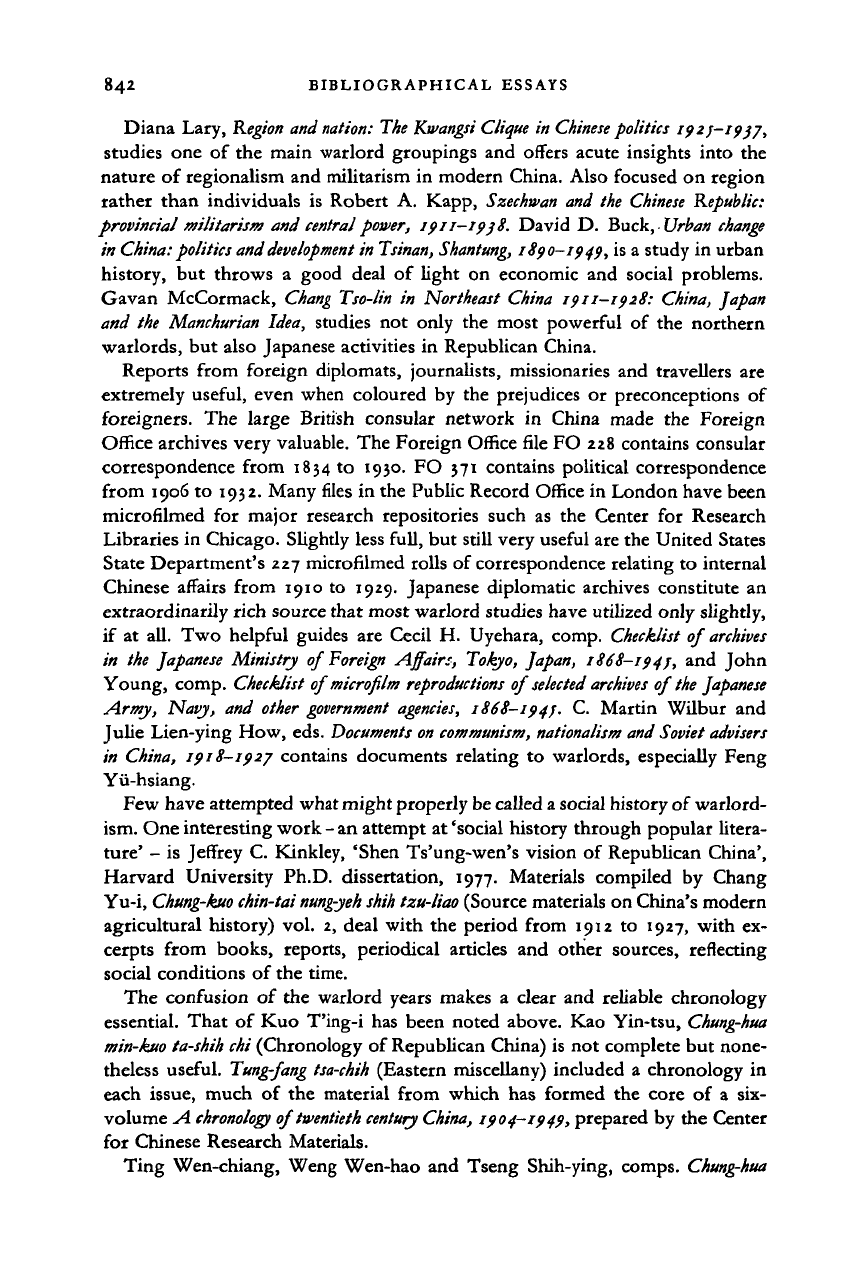
842 BIBLIOGRAPHICAL ESSAYS
Diana Lary,
Region and
nation:
The
Kwangsi Clique
in
Chinese politics
1923-1
studies one of the main warlord groupings and offers acute insights into the
nature of regionalism and militarism in modern China. Also focused on region
rather than individuals is Robert A. Kapp,
Szechwan
and the
Chinese
Republic:
provincial militarism and
central
power,
1911-19)8. David D. Bnck,Urban
change
in
China:
politics and development
in
Tsinan,
Shantung,
1890-1949, is a study in urban
history, but throws a good deal of light on economic and social problems.
Gavan McCormack,
Chang
Tso-lin in Northeast China 1911-1928: China, Japan
and the
Manchurian
Idea, studies not only the most powerful of the northern
warlords, but also Japanese activities in Republican China.
Reports from foreign diplomats, journalists, missionaries and travellers are
extremely useful, even when coloured by the prejudices or preconceptions of
foreigners. The large British consular network in China made the Foreign
Office archives very valuable. The Foreign Office file FO 228 contains consular
correspondence from 1834 to 1930. FO 371 contains political correspondence
from 1906 to 1932. Many files in the Public Record Office in London have been
microfilmed for major research repositories such as the Center for Research
Libraries in Chicago. Slightly less full, but still very useful are the United States
State Department's 227 microfilmed rolls of correspondence relating to internal
Chinese affairs from 1910 to 1929. Japanese diplomatic archives constitute an
extraordinarily rich source that most warlord studies have utilized only slightly,
if at all. Two helpful guides are Cecil H. Uyehara, comp.
Checklist
of
archives
in the
Japanese
Ministry of foreign Affairs, Tokyo, Japan, 1868-194j, and John
Young, comp. Checklist of
microfilm reproductions
of
selected archives
of
the Japanese
Army, Navy, and
other government
agencies,
1868-1943. C. Martin Wilbur and
Julie Lien-ying How, eds.
Documents on
communism,
nationalism and Soviet advisers
in China, 1918-192/ contains documents relating to warlords, especially Feng
Yu-hsiang.
Few have attempted what might properly be called a social history of warlord-
ism. One interesting work - an attempt at 'social history through popular litera-
ture'
- is Jeffrey C. Kinkley, 'Shen Ts'ung-wen's vision of Republican China',
Harvard University Ph.D. dissertation, 1977. Materials compiled by Chang
Yu-i,
Chung-kuo chin-tai nung-yeh shih tzu-liao
(Source materials on China's modern
agricultural history) vol. 2, deal with the period from 1912 to 1927, with ex-
cerpts from books, reports, periodical articles and other sources, reflecting
social conditions of the time.
The confusion of the warlord years makes a clear and reliable chronology
essential. That of Kuo T'ing-i has been noted above. Kao Yin-tsu,
Chung-hua
min-kuo ta-shih chi
(Chronology of Republican China) is not complete but none-
theless useful.
Tung-fang tsa-chih
(Eastern miscellany) included a chronology in
each issue, much of the material from which has formed the core of a six-
volume A
chronology
of
twentieth century
China,
1904-1949, prepared by the Center
for Chinese Research Materials.
Ting Wen-chiang, Weng Wen-hao and Tseng Shih-ying, comps.
Chung-hua
Cambridge Histories Online © Cambridge University Press, 2008
